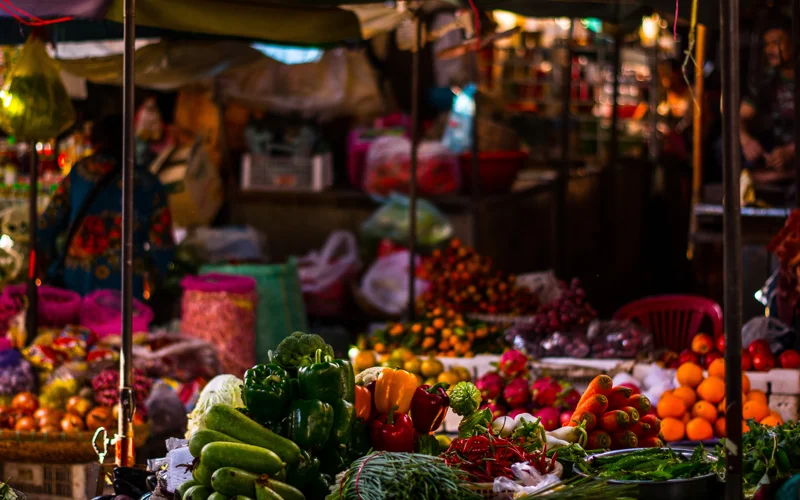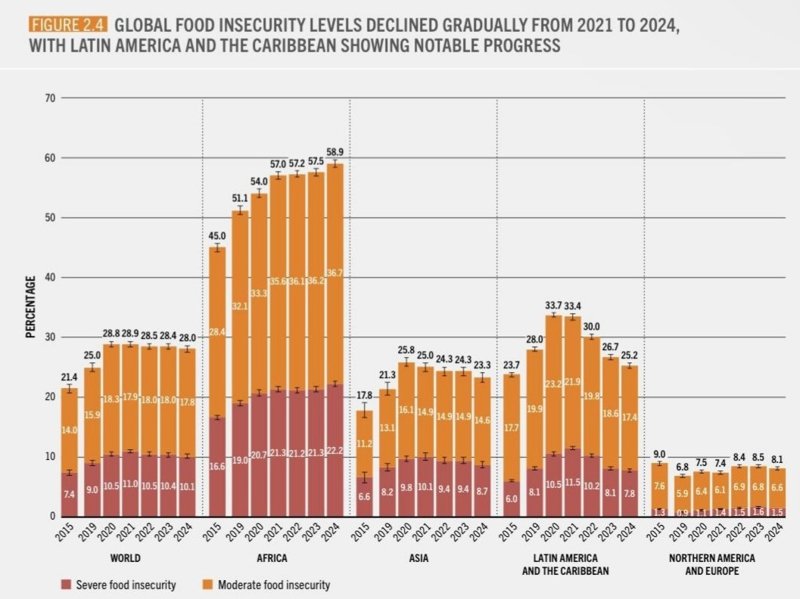Food inflation outpaces recovery as hunger persists despite progress — UN report
The State of Food Security and Nutrition in the World 2025 report, released on 28 July, outlined the lasting impact of food inflation and rising diet costs. Despite some progress, hunger and unaffordable diets remain widespread across low and middle-income countries, Kazinform News Agency correspondent reports on the key findings.

Food prices remain high, healthy diets out of reach
According to the report, food prices have outpaced overall inflation every year since 2020. In January 2023, global food inflation reached 13.6%, compared to 8.5% for headline inflation. In low-income countries, food inflation peaked at 30% in May 2023.
The UN attributes these trends to overlapping factors such as COVID-19 policy responses, ongoing military conflicts, and extreme weather, which have slowed global recovery in food security and nutrition.
In 2024, the average global cost of a healthy diet reached 4.46 purchasing power parity (PPP) dollars per person per day. Latin America and the Caribbean had the highest cost at 5.16, followed by Asia (4.43), Africa (4.41), North America and Europe (4.02), and Oceania (3.86). Africa saw the sharpest increase compared to 2023.
The number of people unable to afford a healthy diet fell from 2.76 billion in 2019 to 2.60 billion in 2024. But this improvement was not shared evenly. In low-income countries, the number rose from 464 million to 545 million. In lower-middle-income countries, excluding India, it rose from 79 million to 869 million.
In 2024, 2.60 billion people, or 31.9% of the world population, still could not afford a healthy diet. In low-income countries, the share reached 72% (544.7 million people). Affordability improved in upper-middle and high-income countries, as well as in India, which contributed to a drop in unaffordability in lower-middle-income countries.
“In times of rising food prices and disrupted global value chains, we must step up our investments in rural and agricultural transformation. These investments are not only essential for ensuring food and nutrition security – they are also critical for global stability,” IFAD President, Alvaro Lario, said.
Food insecurity shows little progress
The global share of people facing moderate or severe food insecurity decreased slightly from 28.4% in 2023 to 28.0% in 2024. This equals 2.3 billion people, 335 million more than in 2019 and 683 million more than in 2015.
Africa had the highest food insecurity rate at 58.9%, more than double the global average. Rates were lower in Latin America and the Caribbean (25.2%), Asia (23.3%), and Oceania (26.3%). The only decline occurred in urban areas, where the rate dropped from 25.7% to 23.9%. Rural (32.0%) and peri-urban (28.6%) rates remained nearly unchanged.

Gender disparities also persist. Although the global gap in food insecurity between men and women narrowed in 2022 and 2023, the report indicates a widening in 2024, with women continuing to face greater levels of food insecurity in every region.
Global hunger declines, but more work to be done
Between 638 and 720 million people experienced hunger in 2024, which is 15 million fewer than in 2023 and 22 million fewer than in 2022, based on the midpoint estimate.

Southern Asia recorded the largest improvement, with the level of undernourishment dropping from 7.9% in 2022 to 6.7% in 2024, or 323 million people. In Latin America and the Caribbean, undernourishment fell to 5.1% (34 million people), down from 6.1% in 2020.
“While it is encouraging to see a decrease in the global hunger rate, we must recognize that progress is uneven. SOFI 2025 serves as a critical reminder that we need to intensify efforts to ensure that everyone has access to sufficient, safe, and nutritious food. To achieve this, we must work collaboratively and innovatively with governments, organizations, and communities to address the specific challenges faced by vulnerable populations, especially in regions where hunger remains persistent,” QU Dongyu, FAO Director-General, stated.
Hunger continued to rise in Africa and Western Asia. In Africa, more than 20% of the population (307 million people) were affected. In Western Asia, 12.7% of the population, which is over 39 million people, faced hunger. Projections suggest that 512 million people could remain chronically undernourished by 2030, with nearly 60% of them living in Africa.
Earlier, Kazinform reported on a separate study that found extreme weather linked to climate change to be increasing food prices around the world.
